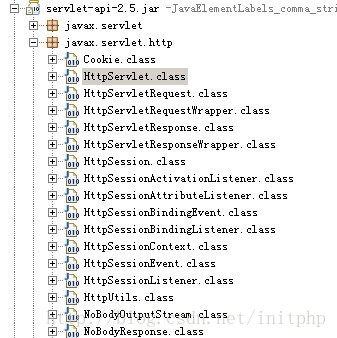
https://blog.csdn.net/initphp/article/details/38171219
一般我们会使用Tomcat来运行Java的web项目。通常我们可以在web项目的目录中可以看到 _**WEB-INF **_这样的文件夹。这个文件夹是受保护的,外部无法通过url来访问的。文件夹里面包含了 _**web.xml **_以及 _**class **_和 _**libs **_目录。我们要将web项目运行起来,就得在web.xml中定义一个Servlet,因为定义了Servlet,web容器才能知道需要如何去分发请求进行业务处理的。
Servlet是有一个Jar包,里面包含了一些Servlet的相关设计和细节。

一个使用Spring的Servlet的web.xml配置例子:
<servlet>
<servlet-name>apiServlet</servlet-name>
<servlet-class>org.springframework.web.servlet.DispatcherServlet</servlet-class>
<init-param>
<param-name>contextConfigLocation</param-name>
<param-value>classpath:spring-common.xml</param-value>
</init-param>
<load-on-startup>1</load-on-startup>
</servlet>
<servlet-mapping>
<servlet-name>apiServlet</servlet-name>
<url-pattern>/api/*</url-pattern>
</servlet-mapping>
HttpServlet是一个抽象类,具体的实现自己需要的Servlet需要通过继承该类来实现 。
HttpServlet中主要的几个方法:
| 方法 | 用途 |
|---|---|
| doGet | 处理HTTP GET请求 |
| doPost | 处理HTTP POST请求 |
| doPut | 处理HTTP PUT请求 |
| doDelete | 处理HTTP DELETE请求 |
Servlet 最终调用的是 service 方法,这个方法中会根据 reques t的 Method 来判断具体是执行doGet还是doPost
可以看下 HttpServlet 类:
package javax.servlet.http;
import java.io.IOException;
import java.io.PrintWriter;
import java.io.OutputStreamWriter;
import java.io.UnsupportedEncodingException;
import java.lang.reflect.Method;
import java.text.MessageFormat;
import java.util.Enumeration;
import java.util.Locale;
import java.util.ResourceBundle;
import javax.servlet.GenericServlet;
import javax.servlet.ServletException;
import javax.servlet.ServletOutputStream;
import javax.servlet.ServletRequest;
import javax.servlet.ServletResponse;
public abstract class HttpServlet extends GenericServlet
implements java.io.Serializable
{
private static final String METHOD_DELETE = "DELETE";
private static final String METHOD_HEAD = "HEAD";
private static final String METHOD_GET = "GET";
private static final String METHOD_OPTIONS = "OPTIONS";
private static final String METHOD_POST = "POST";
private static final String METHOD_PUT = "PUT";
private static final String METHOD_TRACE = "TRACE";
private static final String HEADER_IFMODSINCE = "If-Modified-Since";
private static final String HEADER_LASTMOD = "Last-Modified";
private static final String LSTRING_FILE =
"javax.servlet.http.LocalStrings";
private static ResourceBundle lStrings =
ResourceBundle.getBundle(LSTRING_FILE);
public HttpServlet() { }
//处理HTTP的GET请求,你需要实现一个Servlet,然后实现该方法
protected void doGet(HttpServletRequest req, HttpServletResponse resp)
throws ServletException, IOException
{
String protocol = req.getProtocol();
String msg = lStrings.getString("http.method_get_not_supported");
if (protocol.endsWith("1.1")) {
resp.sendError(HttpServletResponse.SC_METHOD_NOT_ALLOWED, msg);
} else {
resp.sendError(HttpServletResponse.SC_BAD_REQUEST, msg);
}
}
protected long getLastModified(HttpServletRequest req) {
return -1;
}
protected void doHead(HttpServletRequest req, HttpServletResponse resp)
throws ServletException, IOException
{
NoBodyResponse response = new NoBodyResponse(resp);
doGet(req, response);
response.setContentLength();
}
//实现HTTP POST请求
protected void doPost(HttpServletRequest req, HttpServletResponse resp)
throws ServletException, IOException
{
String protocol = req.getProtocol();
String msg = lStrings.getString("http.method_post_not_supported");
if (protocol.endsWith("1.1")) {
resp.sendError(HttpServletResponse.SC_METHOD_NOT_ALLOWED, msg);
} else {
resp.sendError(HttpServletResponse.SC_BAD_REQUEST, msg);
}
}
protected void doPut(HttpServletRequest req, HttpServletResponse resp)
throws ServletException, IOException
{
String protocol = req.getProtocol();
String msg = lStrings.getString("http.method_put_not_supported");
if (protocol.endsWith("1.1")) {
resp.sendError(HttpServletResponse.SC_METHOD_NOT_ALLOWED, msg);
} else {
resp.sendError(HttpServletResponse.SC_BAD_REQUEST, msg);
}
}
protected void doDelete(HttpServletRequest req,
HttpServletResponse resp)
throws ServletException, IOException
{
String protocol = req.getProtocol();
String msg = lStrings.getString("http.method_delete_not_supported");
if (protocol.endsWith("1.1")) {
resp.sendError(HttpServletResponse.SC_METHOD_NOT_ALLOWED, msg);
} else {
resp.sendError(HttpServletResponse.SC_BAD_REQUEST, msg);
}
}
private Method[] getAllDeclaredMethods(Class c) {
if (c.equals(javax.servlet.http.HttpServlet.class)) {
return null;
}
Method[] parentMethods = getAllDeclaredMethods(c.getSuperclass());
Method[] thisMethods = c.getDeclaredMethods();
if ((parentMethods != null) && (parentMethods.length > 0)) {
Method[] allMethods =
new Method[parentMethods.length + thisMethods.length];
System.arraycopy(parentMethods, 0, allMethods, 0,
parentMethods.length);
System.arraycopy(thisMethods, 0, allMethods, parentMethods.length,
thisMethods.length);
thisMethods = allMethods;
}
return thisMethods;
}
protected void doOptions(HttpServletRequest req, HttpServletResponse resp)
throws ServletException, IOException
{
Method[] methods = getAllDeclaredMethods(this.getClass());
boolean ALLOW_GET = false;
boolean ALLOW_HEAD = false;
boolean ALLOW_POST = false;
boolean ALLOW_PUT = false;
boolean ALLOW_DELETE = false;
boolean ALLOW_TRACE = true;
boolean ALLOW_OPTIONS = true;
for (int i=0; i<methods.length; i++) {
Method m = methods[i];
if (m.getName().equals("doGet")) {
ALLOW_GET = true;
ALLOW_HEAD = true;
}
if (m.getName().equals("doPost"))
ALLOW_POST = true;
if (m.getName().equals("doPut"))
ALLOW_PUT = true;
if (m.getName().equals("doDelete"))
ALLOW_DELETE = true;
}
String allow = null;
if (ALLOW_GET)
if (allow==null) allow=METHOD_GET;
if (ALLOW_HEAD)
if (allow==null) allow=METHOD_HEAD;
else allow += ", " + METHOD_HEAD;
if (ALLOW_POST)
if (allow==null) allow=METHOD_POST;
else allow += ", " + METHOD_POST;
if (ALLOW_PUT)
if (allow==null) allow=METHOD_PUT;
else allow += ", " + METHOD_PUT;
if (ALLOW_DELETE)
if (allow==null) allow=METHOD_DELETE;
else allow += ", " + METHOD_DELETE;
if (ALLOW_TRACE)
if (allow==null) allow=METHOD_TRACE;
else allow += ", " + METHOD_TRACE;
if (ALLOW_OPTIONS)
if (allow==null) allow=METHOD_OPTIONS;
else allow += ", " + METHOD_OPTIONS;
resp.setHeader("Allow", allow);
}
protected void doTrace(HttpServletRequest req, HttpServletResponse resp)
throws ServletException, IOException
{
int responseLength;
String CRLF = "\\\\r\\\\n";
String responseString = "TRACE "+ req.getRequestURI()+
" " + req.getProtocol();
Enumeration reqHeaderEnum = req.getHeaderNames();
while( reqHeaderEnum.hasMoreElements() ) {
String headerName = (String)reqHeaderEnum.nextElement();
responseString += CRLF + headerName + ": " +
req.getHeader(headerName);
}
responseString += CRLF;
responseLength = responseString.length();
resp.setContentType("message/http");
resp.setContentLength(responseLength);
ServletOutputStream out = resp.getOutputStream();
out.print(responseString);
out.close();
return;
}
//最终所有的具体实现都是需要实现Service方法.容器最终调用的就是该方法
protected void service(HttpServletRequest req, HttpServletResponse resp)
throws ServletException, IOException
{
String method = req.getMethod();
//这边通过HTTP的方法来判断,具体的HTTP METHOD,然后决定需要执行的方法名称。
if (method.equals(METHOD_GET)) {
long lastModified = getLastModified(req);
if (lastModified == -1) {
// servlet doesn't support if-modified-since, no reason
// to go through further expensive logic
doGet(req, resp);
} else {
long ifModifiedSince = req.getDateHeader(HEADER_IFMODSINCE);
if (ifModifiedSince < (lastModified / 1000 * 1000)) {
// If the servlet mod time is later, call doGet()
// Round down to the nearest second for a proper compare
// A ifModifiedSince of -1 will always be less
maybeSetLastModified(resp, lastModified);
doGet(req, resp);
} else {
resp.setStatus(HttpServletResponse.SC_NOT_MODIFIED);
}
}
} else if (method.equals(METHOD_HEAD)) {
long lastModified = getLastModified(req);
maybeSetLastModified(resp, lastModified);
doHead(req, resp);
} else if (method.equals(METHOD_POST)) {
doPost(req, resp);
} else if (method.equals(METHOD_PUT)) {
doPut(req, resp);
} else if (method.equals(METHOD_DELETE)) {
doDelete(req, resp);
} else if (method.equals(METHOD_OPTIONS)) {
doOptions(req,resp);
} else if (method.equals(METHOD_TRACE)) {
doTrace(req,resp);
} else {
//
// Note that this means NO servlet supports whatever
// method was requested, anywhere on this server.
//
String errMsg = lStrings.getString("http.method_not_implemented");
Object[] errArgs = new Object[1];
errArgs[0] = method;
errMsg = MessageFormat.format(errMsg, errArgs);
resp.sendError(HttpServletResponse.SC_NOT_IMPLEMENTED, errMsg);
}
}
private void maybeSetLastModified(HttpServletResponse resp,
long lastModified) {
if (resp.containsHeader(HEADER_LASTMOD))
return;
if (lastModified >= 0)
resp.setDateHeader(HEADER_LASTMOD, lastModified);
}
public void service(ServletRequest req, ServletResponse res)
throws ServletException, IOException
{
HttpServletRequest request;
HttpServletResponse response;
try {
request = (HttpServletRequest) req;
response = (HttpServletResponse) res;
} catch (ClassCastException e) {
throw new ServletException("non-HTTP request or response");
}
service(request, response);
}
}
HttpServlet最上层是继承Servlet这个接口类。Servlet这个接口类非常简单,只定义了5个方法。